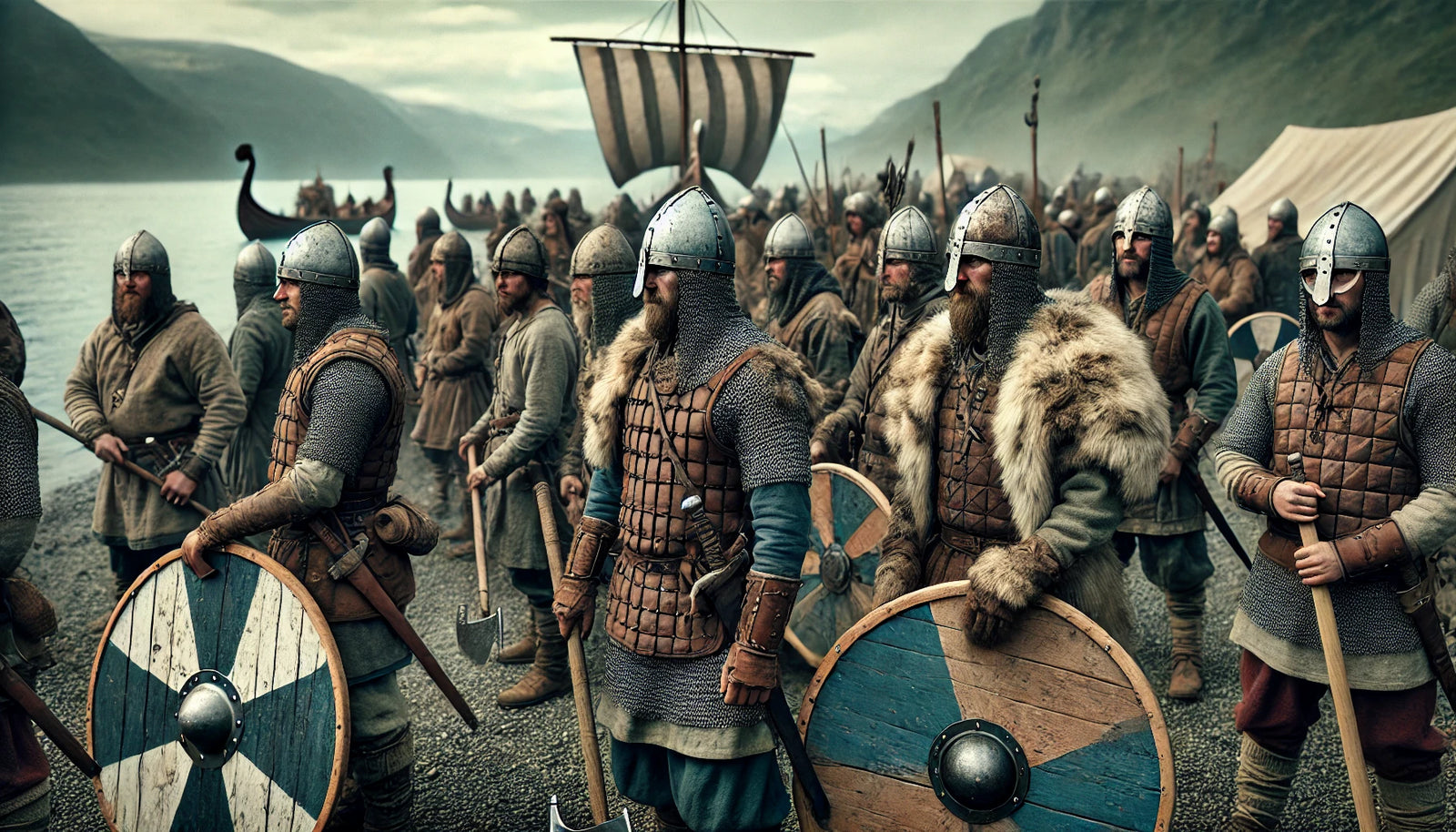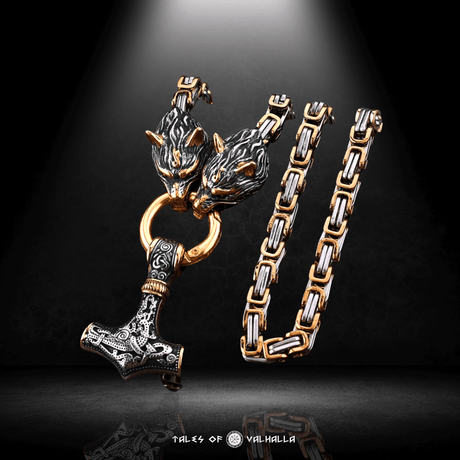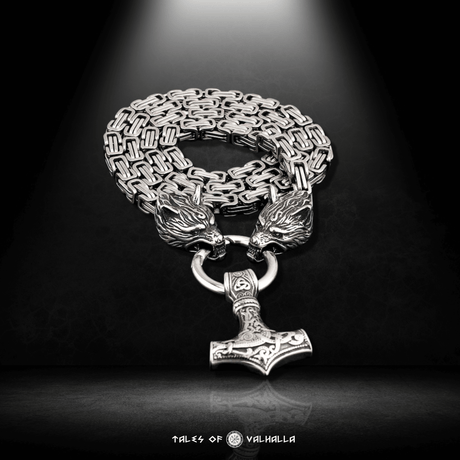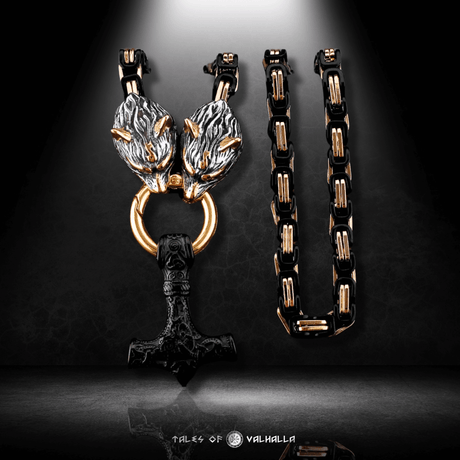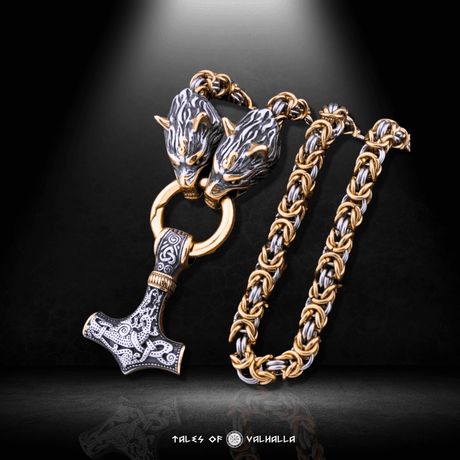Throughout history, Vikings have been known for their fierce raids, their skill in battle, and their unmatched seafaring prowess. Among the essential tools of a Viking warrior, the shield stood out as a powerful symbol of defense, identity, and strength. From early Scandinavian warriors to legendary figures like Bjorn Ironside, the Viking shield was more than a tool for survival—it was a statement of power and resilience. In this article, we explore the evolution of Viking shields, their historical significance, and how these defensive tools played a critical role in shaping the legend of Bjorn Ironside and other Viking leaders.
Shields protected warriors from the most fearsome attacks but also carried symbolic meanings that connected them to the gods, their families, and their communities. As we unravel the history of authentic Viking shields, we’ll dive into the historical Viking shield designs, their roles in warfare, and how the shields’ significance evolved over time. By understanding how Viking shields were constructed and used, we can gain insight into the Viking way of life and the legends that surround them.
The Origins of Viking Shields
To appreciate the significance of Viking shields, it’s important to begin with their origins. Vikings were seafarers, traders, and warriors, but their success was largely due to their superior craftsmanship in making tools and weapons. Shields, in particular, played a dual role: they were vital in combat and deeply symbolic in Viking culture.
Viking Shields and Their Early Use
The earliest Viking shields were round, constructed from wooden planks, and often covered in leather for added durability. Unlike the heavy, full-body shields used by some other cultures, authentic Viking shields were designed to be lightweight and easily maneuverable. This allowed Vikings to carry them while navigating the rough seas or running swiftly into battle.
The historical Viking shield designs were not only practical but also carefully crafted to reflect the warrior's status and clan. Shields could be plain or highly decorative, depending on the wealth and rank of the warrior. For many Viking warriors, including Bjorn Ironside, the shield was not only a means of defense but also a canvas to display their heritage and beliefs.
The Functionality and Craftsmanship of Viking Shields
Viking shields had a unique blend of practicality and artistry. While the shields provided defense in battle, their design and construction were carefully planned to meet the specific needs of Viking warfare. This blend of functionality and craftsmanship is what made Viking shields so effective and enduring.
Viking Shield Materials and Construction
A typical Viking shield was constructed from wood, with linden (lime) being the most common choice due to its lightweight properties. Other woods, such as fir, spruce, and pine, were also used depending on availability. The wooden planks were often joined together and reinforced with iron or leather bindings. The front face of the shield was sometimes covered in leather or canvas, which helped to absorb the impact of enemy blows.

Viking Shield Materials and Construction
At the center of the shield was the boss—a rounded, metal piece that provided additional protection for the hand and allowed the warrior to parry attacks. The Viking shield measurements were typically between 30 and 40 inches in diameter, striking a balance between protection and mobility. The Viking shield size allowed warriors to deflect arrows, swords, and spears while maintaining agility on the battlefield.
For Bjorn Ironside and other Viking leaders, the craftsmanship of their shields was critical. Shields had to be strong enough to withstand repeated blows, yet light enough to maneuver quickly in the heat of battle.
Reinforcing Viking Shields for Battle
Vikings reinforced their shields by attaching leather strips or iron rims around the edges to prevent the shield from splitting during combat. This extra reinforcement was particularly useful in naval battles, where Viking warriors faced enemy forces on board ships. Bjorn Ironside, known for his daring raids along the coasts of Western Europe and the Mediterranean, would have relied on these reinforced shields to protect himself and his men during intense ship-to-ship combat.
The authentic Viking shields used in these battles were essential for close-quarters fighting, allowing warriors to block incoming attacks and strike back with swords or axes. For Vikings, shields were as much offensive weapons as they were defensive ones.
The Viking Shield Wall: A Formidable Defense
One of the most iconic battle formations in Viking history was the shield wall—a defensive technique that allowed warriors to form an impenetrable barrier against their enemies. The shield wall became a hallmark of Viking warfare, and it was a tactic employed by great Viking leaders like Bjorn Ironside.

The Viking Shield Wall: A Formidable Defense
The Tactical Advantage of the Viking Shield Wall
In a Viking shield wall, warriors stood shoulder to shoulder, with their shields locked together to form a continuous line of defense. This tactic was especially effective in repelling enemy attacks, as the overlapping shields protected the warriors from head to toe. The shield wall allowed the Vikings to push forward in unison, advancing on their enemies while minimizing the risk of injury.
The effectiveness of the shield wall lay in its simplicity. By creating a unified barrier, the Vikings could move as a single entity, overwhelming their opponents through sheer force. For Bjorn Ironside, who led numerous raids into hostile territories, the shield wall would have been an indispensable tactic. It allowed his forces to engage larger armies and maintain cohesion during the chaos of battle.
The Psychological Impact of Viking Shields in Battle
The Viking shield wall wasn’t just a physical defense—it also had a profound psychological effect on the battlefield. The sight of a Viking army advancing with their shields locked together, painted with fearsome designs and symbols, was enough to terrify even the most seasoned enemies.
Historical Viking shield designs often included menacing symbols such as the raven, associated with Odin, or intricate knotwork patterns that symbolized strength and protection. These designs were meant to strike fear into the hearts of the Vikings’ enemies, making the shield an important tool of intimidation as well as defense.
Bjorn Ironside’s shields likely bore similar designs, symbolizing his authority as a leader and his connection to the gods. As a descendant of Ragnar Lothbrok, Bjorn would have carried shields that reflected his lineage and his divine right to rule.
The Symbolism of Viking Shields
Beyond their practical use in battle, Viking shields were rich in symbolism. They represented protection, power, and the warrior’s connection to the gods. The intricate designs and symbols that adorned Viking shields were not just for decoration—they held deep cultural and religious significance.
Viking Shield Designs and Meanings
The symbols painted on Viking shields were chosen carefully, each with its own meaning and significance. The raven was one of the most common symbols, representing Odin, the god of wisdom, war, and death. Vikings believed that by carrying the raven on their shields, they would invoke Odin’s protection and favor in battle.

Viking Shield Designs and Meanings
Other symbols included the Helm of Awe (Ægishjálmr), a magical symbol that was believed to provide protection and inspire fear in enemies. This symbol was often painted on shields to grant the warrior invulnerability in battle and ensure victory.
For Viking leaders like Bjorn Ironside, shield designs also reflected their personal status and family lineage. Shields could feature intricate knotwork patterns, runes, and other designs that symbolized the warrior’s place within the Viking hierarchy. The use of these symbols allowed Vikings to communicate their beliefs and allegiances through their shields.
The Use of Color in Viking Shields
Color was another important aspect of Viking shield designs. Shields were often painted in bright colors such as red, yellow, blue, and black. These colors were not chosen randomly; they carried specific meanings:
- Red symbolized blood, courage, and warfare.
- Yellow represented wealth, prosperity, and the favor of the gods.
- Blue was associated with loyalty, honor, and the sea—a crucial element of Viking life.
- Black symbolized death, mystery, and the unknown, adding an air of intimidation to the Viking warrior’s appearance.
The use of color and symbols on Viking shields allowed warriors to express their personal identity and convey messages to both their allies and enemies. For Bjorn Ironside, whose reputation as a fierce warrior and skilled tactician preceded him, the designs on his shields would have further emphasized his authority and strength.
Viking Shields and Their Role in Raids
Viking raids were fast, brutal, and meticulously planned. Shields were an essential tool in the success of these raids, providing protection during the initial assault and throughout the subsequent battles. From coastal monasteries to well-fortified cities, Viking shields played a crucial role in allowing the Vikings to conquer new territories.
Shields in Naval Warfare
Viking longships were designed for speed and agility, allowing the Vikings to launch surprise attacks on coastal settlements. During naval battles, shields were used to defend against incoming arrows and spears as the Vikings closed in on their targets. The round shape of the Viking shield was particularly effective in these scenarios, as it allowed warriors to deflect projectiles from multiple angles.
Bjorn Ironside, known for his extensive naval campaigns, would have relied on his shields to protect himself and his men during these daring raids. His legendary journey into the Mediterranean, where he raided cities like Luna and possibly Rome, would have required the use of well-crafted shields to withstand the defensive efforts of his enemies.
Viking Shields on Land: Breaking Through Enemy Defenses
Once the Vikings reached land, their shields became even more critical. Viking warriors often faced fortified settlements with high walls and well-armed defenders. The shield wall allowed the Vikings to protect themselves as they advanced on enemy positions, creating a mobile defense that could withstand even the most determined counterattacks.
In hand-to-hand combat, Viking shields were used to block and deflect enemy blows while allowing the warrior to strike back with a sword or axe. The versatility of the Viking shield made it one of the most effective tools in the Viking arsenal, allowing warriors like Bjorn Ironside to engage in combat with confidence.
What Did Vikings Wear for Armor? A Look at Viking Protection
While shields provided the primary means of defense for Viking warriors, they were often used in conjunction with other forms of armor. Understanding what Vikings wore for armor helps to complete the picture of a fully equipped Viking warrior.

What Did Vikings Wear for Armor?
Helmets, Chainmail, and Leather Armor
Viking armor was designed to be functional and practical, allowing warriors to move quickly and fight effectively. Helmets were an important part of Viking armor, although they were not as elaborate as some modern depictions suggest. Viking helmets were typically made of iron and consisted of a rounded cap with a nose guard for added protection.
Chainmail was another key component of Viking armor, though it was expensive and primarily worn by wealthier warriors or chieftains. Chainmail provided excellent protection against slashing attacks, as the interlocking metal rings absorbed and distributed the force of a blow.
For most Viking warriors, leather armor was the standard form of protection. Leather was light and flexible, allowing the warrior to maintain mobility while still offering some defense against enemy strikes. In some cases, leather armor was reinforced with metal plates or scales to provide additional protection.
Shields as Armor
In many cases, the Viking shield served as the warrior’s primary means of protection. Vikings relied heavily on their shields to block incoming attacks, and a well-crafted shield could absorb the impact of swords, spears, and arrows. For Vikings who could not afford chainmail or other expensive armor, the shield was their most valuable piece of equipment.
In Bjorn Ironside’s time, shields were essential for survival on the battlefield. As a leader who commanded numerous raids and battles, Bjorn would have understood the importance of equipping his warriors with strong, reliable shields.
Viking Shields in Popular Culture
The Viking shield has become an iconic symbol of Viking culture, appearing in films, TV shows, and reenactments around the world. Popular culture has helped to cement the image of the Viking warrior, complete with a round wooden shield, sword, and helmet.
Bjorn Ironside’s Shield in Vikings
In the TV series Vikings, Bjorn Ironside is often depicted with a shield in hand, leading his men into battle. The show’s portrayal of Viking shields captures the essence of Viking warfare and the importance of the shield as both a defensive and offensive weapon.
While the show takes creative liberties with historical accuracy, it reflects the essential role that shields played in Viking culture. The bright colors, intricate designs, and symbolism of the shields are accurately depicted, giving viewers a glimpse into the artistry and craftsmanship of authentic Viking shields.
Conclusion
The Viking shield is more than just a tool of war; it is a powerful symbol of the Viking way of life. For legendary figures like Bjorn Ironside, the shield represented not only protection in battle but also their connection to their ancestors, their gods, and their communities. The historical Viking shield designs, the craftsmanship that went into their construction, and their use in warfare all contribute to the enduring legacy of Viking shields.
FAQ
1. What were Viking shields made of?
Viking shields were typically made from wood, with linden (limewood) being the most common choice due to its light weight and durability. The shield’s wooden core was often reinforced with leather or rawhide to strengthen its edges, and it featured a central metal boss that protected the hand and provided a solid grip.
2. How big were Viking shields?
Viking shields were generally circular and measured between 30 to 36 inches (76 to 91 cm) in diameter. This size struck a balance between offering ample protection and being easy to maneuver during battle. The thickness of the shield varied, but it was usually around 0.5 to 0.75 inches (1.3 to 1.9 cm) thick.
3. What was the purpose of the metal boss in the center of a Viking shield?
The metal boss, located in the center of a Viking shield, served to protect the warrior’s hand during battle. It was also used offensively, allowing the Viking to deflect blows and potentially strike enemies. The boss was typically made from iron and reinforced the most vulnerable part of the shield.
4. Did Viking shields have any specific designs or symbols?
Yes, Viking shields often featured designs and symbols that held cultural or personal significance. These could include depictions of animals like ravens (symbolizing Odin) or patterns like runes and knots. Bright colors such as red, yellow, black, and blue were also used, with each color having specific meanings tied to war, protection, or family lineage.
5. What was the Viking shield wall, and how was it used in battle?
The shield wall was a defensive formation used by Viking warriors. In this formation, warriors would stand side by side, overlapping their shields to form a continuous, impenetrable barrier. This tactic allowed the Vikings to protect themselves while advancing toward their enemies in unison, making it highly effective during hand-to-hand combat and against archers.
6. Are there any Viking shields that have been discovered by archaeologists?
While wood does not always survive well over time, some Viking shield fragments and remnants have been discovered, particularly from burial sites like the Gokstad ship burial in Norway. These finds have helped historians reconstruct what authentic Viking shields looked like, how they were made, and how they were used in battle.

